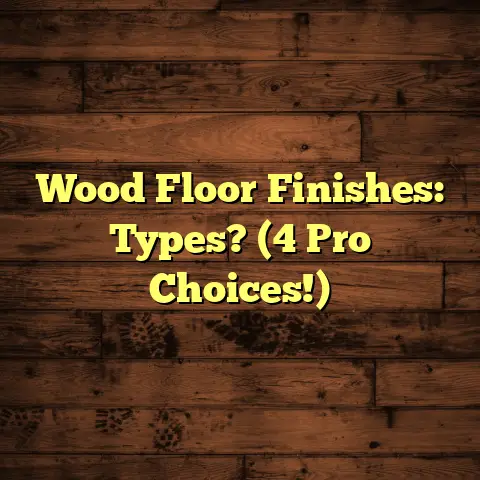How To Stop Creaking Floors In An Apartment?
There’s this myth floating around that creaking floors are just a sign of an old building and can’t be fixed.
Honestly, that’s just not true. While older buildings might be more prone to creaks, even newer constructions can have this issue.
Think of this article as your go-to guide to understanding and tackling those annoying creaks.
Creaking floors aren’t just a nuisance; they can also be a sign of underlying problems that, thankfully, we can often address.
Let’s dive in and get your apartment sounding less like a haunted house and more like the peaceful haven it should be!
Section 1: Understanding Creaking Floors
Okay, so what exactly are creaking floors?
Essentially, it’s any unwanted noise your floor makes when you walk on it. We’re talking about those squeaks, groans, and pops that seem to echo through your entire apartment.
But what causes these noises? Well, it’s all about friction.
Think about it: your floor isn’t just one solid piece. It’s made up of floorboards (or tiles, laminate, etc.), a subfloor underneath, and joists (the structural beams that support everything).
When these components rub against each other, especially when they’re loose or dry, you get that dreaded creak.
Here’s a quick breakdown of the usual suspects behind creaking floors:
-
Temperature Changes: Wood expands and contracts with temperature fluctuations. This can loosen nails and screws, leading to movement and creaking.
-
Humidity: Similar to temperature, humidity changes cause wood to swell or shrink. Excessive moisture can also lead to wood rot, further weakening the structure. According to the EPA, ideal indoor humidity should be between 30-50% https://www.epa.gov/indoor-air-quality-iaq/what-are-some-factors-affect-indoor-air-quality.
-
Structural Issues: Over time, the foundation of your building can settle, causing shifts in the subfloor and joists. This puts stress on the flooring and can lead to creaks.
-
Loose Fasteners: Nails and screws holding the floorboards to the subfloor can loosen over time due to vibrations and everyday use.
-
Friction: As mentioned earlier, the rubbing of floorboards against each other or against the subfloor is a primary cause of creaking.
Understanding these causes is the first step to silencing those noisy floors. Now, let’s bust some myths!
Section 2: Common Myths About Creaking Floors
Let’s debunk some common misconceptions I hear all the time:
Myth 1: “Creaking floors are just a natural part of living in an apartment.”
I get why people think this. Especially in older buildings, creaking floors can seem like an inevitable part of the experience.
But that doesn’t mean you have to live with it!
Ignoring creaking floors can lead to inaction, and sometimes, the underlying issues can worsen over time.
Think of it like ignoring a leaky faucet – it might start as a drip, but eventually, it could cause water damage.
Myth 2: “You can’t fix creaking floors without tearing up the entire floor.”
This is a big one, and it scares a lot of people. The thought of a major renovation is definitely a deterrent.
The good news is that there are plenty of alternative solutions you can try without resorting to a complete floor overhaul.
We’ll talk about some DIY fixes later on that can often do the trick.
Myth 3: “Creaks only happen in wooden floors.”
While hardwood floors are definitely prone to creaking, they’re not the only culprits.
Laminate, tile, and even some carpeted floors can experience noise issues.
For example, laminate floors can creak if they’re not properly installed or if the subfloor is uneven.
Tile floors can creak if the grout is cracked or if the underlying mortar bed is failing.
Even carpet can contribute to noise if it’s not properly padded or if the subfloor underneath is the source of the problem.
The important thing is to identify the source of the noise, regardless of the flooring type.
Section 3: Diagnosing the Problem
Alright, let’s put on our detective hats and figure out where those creaks are coming from.
Here’s a step-by-step guide to help you pinpoint the source:
-
Inspecting the Area: Start by visually inspecting the area where you hear the creaking. Look for loose boards, gaps between boards, or any signs of damage. Pay close attention to areas near walls, doorways, and high-traffic zones.
-
Listening for Noise Patterns: Walk around the area and try to identify specific spots that trigger the creaking. Does the noise come from a particular board or a general area? Is it a consistent squeak or an intermittent groan? Note these patterns.
-
Checking the Foundation and Subflooring: This might require a bit more effort, but it’s crucial. If you have access to the crawl space or basement beneath the affected area, inspect the subfloor and joists for any signs of damage, rot, or movement. Use a flashlight to get a good view.
-
Understanding Your Flooring Type: Knowing what type of flooring you have is essential for proper diagnosis. Hardwood floors will have different issues than laminate or tile. Research common problems associated with your specific flooring type to narrow down the possibilities.
Let me give you an example from a recent job I did.
A client called me about a creaking floor in their living room.
After inspecting the area, I noticed that the creaking was most prominent near the fireplace.
Upon closer examination, I found that the subfloor around the fireplace had been slightly damaged by water, likely from a leaky chimney.
This caused the floorboards to rub against each other, resulting in the creaking.
The solution involved repairing the subfloor and securing the floorboards properly.
Here’s a quick checklist to help you diagnose the problem:
| Step | Description |
|---|---|
| Visual Inspection | Look for loose boards, gaps, damage, and signs of water damage. |
| Noise Patterns | Identify specific spots that trigger the creaking and note the type of noise. |
| Subfloor Check | If possible, inspect the subfloor and joists for damage, rot, or movement. |
| Flooring Type | Determine the type of flooring (hardwood, laminate, tile, etc.) and research common issues associated with it. |
Remember, a thorough diagnosis is key to finding the right solution. Don’t rush this step!
Section 4: DIY Solutions for Creaking Floors
Now for the fun part: fixing those creaks yourself!
Here’s a comprehensive list of DIY methods you can try:
-
Tightening Screws and Nails: This is often the first and easiest solution. Locate the loose floorboards and use a screwdriver or nail gun to secure them to the subfloor. If the existing holes are stripped, use slightly larger screws or nails.
-
Using Talcum Powder or Graphite: These lubricants can reduce friction between boards. Sprinkle talcum powder or graphite into the cracks between the floorboards and work it in with a brush or cloth. This can help to silence minor squeaks.
-
Adding Shims: Shims are thin pieces of wood or plastic that can be inserted between the subfloor and the floorboards to provide support and eliminate movement. Use a utility knife to trim the shims to the appropriate size and tap them into place with a hammer.
-
Installing a Subfloor: In some cases, adding a layer of subflooring can enhance stability and reduce creaking. This is a more involved project, but it can be effective for addressing widespread creaking issues.
Let’s break down each method in more detail:
Tightening Screws and Nails
This is usually my first go-to. It’s simple, effective, and doesn’t require a ton of tools.
Walk around the creaking area and try to pinpoint the exact spot where the noise is coming from.
Once you’ve found it, use a screwdriver (or a nail gun, if you’re comfortable with it) to tighten the screws or nails that are holding the floorboard in place.
If the screws or nails are just spinning and not grabbing, it means the hole is stripped.
In that case, try using a slightly larger screw or nail.
You can also insert a small wooden dowel or toothpick into the hole to give the screw something to grip onto.
Using Talcum Powder or Graphite
This is a great solution for those annoying little squeaks that seem to come from everywhere.
Talcum powder and graphite are both excellent lubricants that can reduce friction between floorboards.
Simply sprinkle the powder or graphite into the cracks between the boards and work it in with a brush or cloth.
Be careful not to use too much, as it can be messy.
Adding Shims
Shims are thin, tapered pieces of wood that you can use to fill gaps between the subfloor and the floorboards.
This helps to stabilize the floorboards and prevent them from moving and creaking.
To install shims, you’ll need to locate the gap between the subfloor and the floorboard.
You can usually do this by feeling around with your hand or by using a flashlight to look for any openings.
Once you’ve found the gap, insert the shim and tap it into place with a hammer.
Be careful not to force the shim in too far, as this can damage the floorboards.
Installing a Subfloor
This is the most involved DIY solution, but it can be very effective for addressing widespread creaking issues.
Installing a new subfloor involves laying a layer of plywood or OSB over the existing subfloor.
This adds stability and helps to even out any unevenness in the existing subfloor.
Before you install a new subfloor, make sure to address any underlying issues, such as water damage or rot.
Here’s a table summarizing the DIY solutions:
| Solution | Description |
|---|---|
| Tightening Fasteners | Locate and secure loose floorboards with screws or nails. Use larger fasteners or fill stripped holes if needed. |
| Lubrication | Apply talcum powder or graphite to cracks between floorboards to reduce friction. |
| Shimming | Insert shims between the subfloor and floorboards to provide support and eliminate movement. |
| Subfloor Installation | Add a layer of plywood or OSB over the existing subfloor for enhanced stability. |
Remember to always wear safety glasses and gloves when working on DIY projects.
Section 5: Professional Solutions
Okay, so you’ve tried the DIY methods, but those creaks are still haunting you.
When is it time to call in the pros?
Here are a few scenarios where professional help is necessary:
-
Structural Issues: If you suspect that the creaking is caused by structural problems, such as damaged joists or foundation settlement, it’s crucial to consult with a professional contractor. These issues can be complex and require specialized knowledge and equipment to address.
-
Extensive Damage: If the creaking is widespread and accompanied by other signs of damage, such as water damage, rot, or insect infestation, it’s best to seek professional help. These issues can be difficult to resolve on your own and may require extensive repairs.
-
Lack of Experience: If you’re not comfortable working on DIY projects or if you lack the necessary tools and skills, it’s always a good idea to hire a professional. A qualified contractor can diagnose the problem accurately and provide effective solutions.
Here are some services that professionals can provide:
-
Floor Refinishing: If your hardwood floors are worn or damaged, refinishing can help to restore their appearance and eliminate creaking. This process involves sanding down the old finish and applying a new coat of sealant.
-
Subfloor Replacement: If the subfloor is severely damaged or rotten, it may need to be replaced entirely. This is a more involved project, but it can be necessary to address serious structural issues.
-
Joist Repair: If the joists are damaged or weakened, they may need to be repaired or replaced. This can involve sistering new joists to the existing ones or replacing them entirely.
Tips for Choosing the Right Contractor:
-
Get Referrals: Ask friends, family, or neighbors for recommendations.
-
Check Credentials: Make sure the contractor is licensed and insured.
-
Read Reviews: Look for online reviews to get an idea of the contractor’s reputation.
-
Get Multiple Quotes: Compare quotes from several contractors before making a decision.
-
Ask Questions: Don’t be afraid to ask the contractor questions about their experience, qualifications, and approach to the project.
Remember, hiring a professional is an investment in the long-term health and stability of your floors.
Don’t hesitate to seek help if you’re not comfortable tackling the problem on your own.
Section 6: Preventive Measures to Avoid Future Creaking
Okay, so you’ve silenced those creaks. Now, how do you keep them from coming back?
Here are some preventive strategies to help you maintain your floors and prevent future creaking:
-
Maintain Indoor Humidity Levels: As we discussed earlier, humidity fluctuations can cause wood to expand and contract, leading to creaking. Use a humidifier or dehumidifier to maintain a consistent humidity level in your home, ideally between 30-50%.
-
Regularly Check and Maintain Floor Integrity: Inspect your floors regularly for any signs of damage, such as loose boards, gaps, or water stains. Address these issues promptly to prevent them from worsening.
-
Furniture Placement: Avoid placing heavy furniture in areas that are prone to creaking. Distribute the weight evenly across the floor to minimize stress on the subfloor and joists.
-
Avoid Excessive Weight: Avoid placing excessive weight on certain areas of the floor, such as near walls or doorways. This can overload the subfloor and joists, leading to creaking.
Let’s delve a bit deeper into each of these strategies:
Maintaining Indoor Humidity Levels
This is crucial, especially if you live in an area with extreme weather conditions.
During the winter months, when the air is dry, use a humidifier to add moisture to the air.
During the summer months, when the air is humid, use a dehumidifier to remove excess moisture.
You can also use an air conditioner to help regulate humidity levels.
Regularly Checking and Maintaining Floor Integrity
Make it a habit to inspect your floors regularly, just like you would with your car or your home’s HVAC system.
Look for any signs of damage, such as loose boards, gaps, or water stains.
If you spot any issues, address them promptly to prevent them from worsening.
For example, if you notice a loose floorboard, tighten the screws or nails right away.
If you see a water stain, investigate the source of the leak and fix it before it causes further damage.
Furniture Placement
Think about how you’re arranging your furniture.
Avoid placing heavy furniture in areas that are prone to creaking.
Distribute the weight evenly across the floor to minimize stress on the subfloor and joists.
For example, instead of placing a heavy bookcase against a wall, try distributing the weight by placing it in the center of the room.
Avoiding Excessive Weight
Be mindful of how much weight you’re placing on certain areas of the floor.
Avoid placing excessive weight near walls or doorways, as these areas are often more prone to creaking.
For example, if you’re planning a party, try to avoid having too many people congregating in one area.
Here’s a table summarizing the preventive measures:
| Measure | Description |
|---|---|
| Humidity Control | Maintain indoor humidity levels between 30-50% using a humidifier or dehumidifier. |
| Regular Inspection | Inspect floors regularly for damage, loose boards, or water stains. |
| Strategic Furniture Placement | Avoid placing heavy furniture in creak-prone areas and distribute weight evenly. |
| Weight Distribution | Avoid placing excessive weight on specific areas of the floor. |
By following these preventive measures, you can help to keep your floors in good condition and prevent future creaking.
Section 7: Living with Creaking Floors
Sometimes, despite your best efforts, you might not be able to completely eliminate creaking floors.
What do you do then?
Here’s some advice on how to cope with creaking floors if immediate fixes aren’t possible:
-
Soundproofing Options: Consider using soundproofing materials to minimize the noise. Rugs, carpets, and underlayment can help to absorb sound and reduce the impact of footsteps.
-
Floor Coverings: Choose floor coverings that can absorb sound. Carpets and rugs are excellent choices, but even thicker laminate or vinyl flooring can help to reduce noise.
-
Communicate with Landlords: If you’re renting, communicate with your landlord or property manager about the persistent floor issues. They may be willing to address the problem or offer solutions to help mitigate the noise.
Let’s explore these options in more detail:
Soundproofing Options
Rugs and carpets are your best friends when it comes to soundproofing.
They not only add warmth and comfort to your apartment, but they also help to absorb sound and reduce the impact of footsteps.
Consider using thick, plush rugs in areas where you spend a lot of time, such as the living room and bedroom.
You can also use soundproof underlayment beneath your flooring to further reduce noise transmission.
Floor Coverings
When choosing floor coverings, opt for materials that are known for their sound-absorbing properties.
Carpets and rugs are always a good choice, but you can also consider thicker laminate or vinyl flooring.
These materials tend to be more sound-absorbent than thinner, less dense options.
Communicating with Landlords
If you’re renting, it’s important to communicate with your landlord or property manager about the creaking floors.
They may be willing to address the problem themselves, or they may be able to offer suggestions for mitigating the noise.
Be sure to document your communication with your landlord in writing, and keep a record of any expenses you incur as a result of the creaking floors.
Here’s a table summarizing the coping strategies:
| Strategy | Description |
|---|---|
| Soundproofing | Use rugs, carpets, and soundproof underlayment to absorb sound and reduce noise transmission. |
| Sound-Absorbent Coverings | Choose floor coverings like carpets, rugs, or thicker laminate/vinyl to reduce noise. |
| Landlord Communication | Communicate with your landlord or property manager about the issue and explore potential solutions. |
Living with creaking floors can be frustrating, but by implementing these strategies, you can minimize the noise and create a more comfortable living environment.
Conclusion
So, there you have it.
We’ve dispelled the myth that creaking floors are an unfixable part of apartment living.
I hope you feel empowered to take the necessary steps to diagnose and address your creaking floors.
Remember, with the right knowledge and resources, you can enjoy a quieter, more comfortable living environment.
Don’t let those creaks get you down! Take action, and reclaim your peace and quiet. Good luck!





